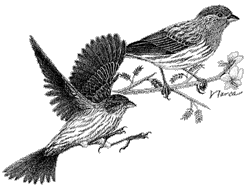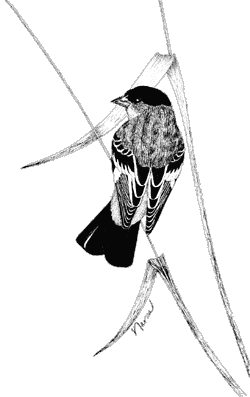Finches
The bird world includes few vegetarians. Even most birds adapted for eating seeds—such as the sparrows and grosbeaks, with their thick seed-crushing bills—switch over mostly to insects in summer, and feed their young on a high-protein insect diet. However, the true finches stick with plant material all year long, feeding on seeds, buds, and berries, with only the occasional insect. Their young are fed the same fare, although at first they receive their seeds in a softened, partly digested, form.
 |
Wild seed crops vary from season to season, so many finches are somewhat nomadic, their flocks moving around in response to changing food supplies. Lesser Goldfinches live year-round in the Sonoran Desert, but sometimes they are locally abundant. Where the flower heads of fiddlenecks (Amsinckia spp.) are going to seed, for example, Lesser Goldfinches may descend in flocks, bringing flashes of color and a constant musical twittering. At other times, they may be seen only as isolated couples. A pair may raise young any time from early spring to late fall, perhaps when food supplies seem favorable.
Less nomadic is the House Finch, which has adopted a winning strategy: it is adapted to living around humans. House Finches in our region may have learned to live around Native American villages centuries ago, and they found an equally good niche around farms, suburbs, and big cities. Accidentally introduced into the eastern United States about 1940, House Finches are now found from coast to coast, but in many areas they are strictly urban dwellers. Not so in the Southwest. Here they do well in the cities, but they also continue to thrive in desert canyons, where these attractive and musical little finches had lived all along.
—Kenn KaufmanRepresentative Sonoran Desert species:
House Finch (Carpodacus mexicanus)
Lesser Goldfinch (Carduelis psaltria)
Order: Passeriformes
Family: Fringillidae (Finches)
Spanish names: gorrión común, gorrión doméstico (finch)
Distinguishing features
House Finch male: brownish with shiny pink or orange-pink crown, rump, and breast; heavy streaking on the sides and back. Female: all brown, heavily streaked underparts. Lesser Goldfinch male: black cap, black or green upperparts, bright yellow underparts, white wing bars on black wings. Female: greenish upperparts, yellow underparts, black wings and tail, white wing bars.
Habitat
The House Finch inhabits ranches, towns, canyons and agricultural areas; found in deserts only where water is available; often seen at bird feeders, nesting on porch lights, or under eaves.
The Lesser Goldfinch is found in open or semi-open areas where there are trees or brushy vegetation; found near water in more arid regions; also visits suburban gardens.
Feeding
• Diet: Almost entirely seeds, buds, and other vegetable matter; feeds on insects to a lesser extent.
• Behavior: Both species forage in flocks, except during nesting season. The House Finch forages on the ground and in trees or shrubs; it will come to bird feeders offering seeds or sugar water. The Lesser Goldfinch is an active and acrobatic forager in trees, shrubs, and weeds.
Life History
 |
House Finch: The female builds a compact cup-shaped nest of grasses, hair, cotton, and other plant fibers; the nest is placed in a cactus, low tree, or shrub, or on a building ledge. The female incubates the 2 to 6 black and lavender dotted pale blue eggs for about 2 weeks. The male feeds the female during courtship and incubation. Both parents feed nestlings; the young fledge in 12 to 15 days. This bird may nest several times during one season.
Lesser Goldfinch: During courtship the male keeps close to the female, often perching near her and singing. The female builds an open cup-shaped nest of grasses, hair, feathers, other plant matter; the nest is typically placed in trees from 15 to 40 feet (5-13 m) above the ground. The female incubates the 3 to 6 pale bluish-white unmarked eggs for about 2 weeks. The male feeds the female during during incubation. Both parents feed nestlings; the young fledge in 11 to 13 days. In the Sonoran Desert region, breeding season is quite long, extending from February or March to September or October.










